The way a guitar neck is connected to a guitar body plays an important role in tone as well as how a guitar feels to play.
The three main types of neck joints used on guitar are bolt-on, set neck, and neck-through. Bolt-on necks are attached to the body using screws. Set necks are glued to the guitar body. Neck-through necks run all the way through the guitar body as one piece of wood.
In this guide, let’s take a closer look at each type of guitar neck joint, how the type of joint impacts tone, and how it impacts playability.
I’ll also cover common myths about sustain and tone that many guitarists believe about neck joints.
By the end of this guide, you’ll know how to instantly identify different types of neck joints on guitars and you’ll know which type may be right for you.
After you read this guide, read the guides on guitar neck shapes, action height, intonation, and truss rods to learn more about guitar necks and playability.
What are Bolt-On Necks
Bolt-on guitar necks are extremely common on electric guitars and the easiest to identify. Despite what the name suggests, bolts aren’t used to attach the neck.
A bolt-on guitar neck is screwed into the guitar body. Sometimes a metal plate is used to hold the neck in place, but this isn’t always used.
In the below photo, you can see the typical bolt-on neck found on a Fender Stratocaster:

A metal plate is placed on the back of the guitar’s body to hold the screws in place.
It’s important to keep in mind that the neck isn’t glued to the body – only the screws hold it in place.
The below photo shows another type of bolt-on guitar neck that doesn’t use a metal plate:
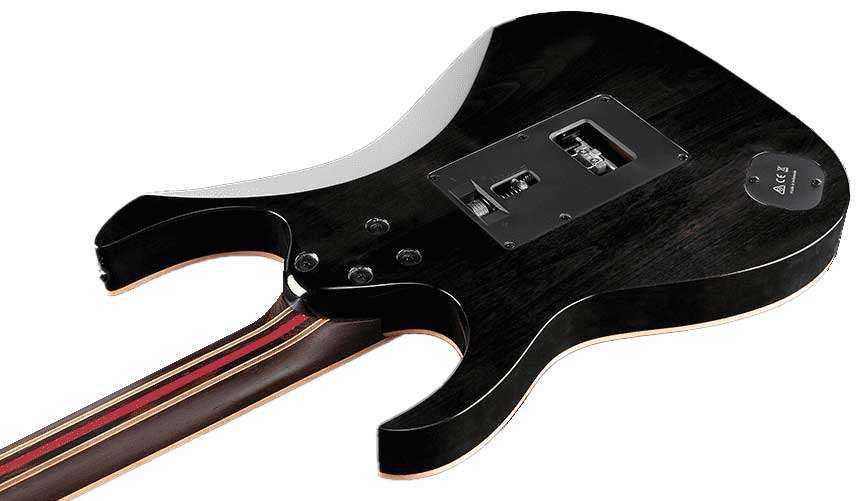
Guitars with this type of bolt-on joint tend to feel more ergonomic or smoother under the hand compared to the square joint used to mount the plate. You can see that without the plate, the neck joint can have more contours to smooth out the edges.
The key point in identifying a guitar with a bolt-on neck joint is the use of screws. If you don’t see any screws in the neck joint, it will be one of the other two types as covered below.
Bolt-on necks can be found on acoustic guitars, but the bolts are internal, so you may not notice them at all.
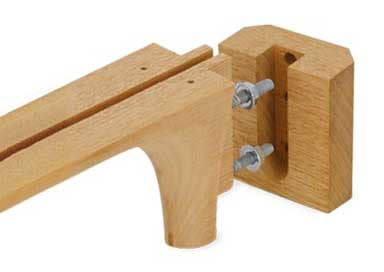
The way to tell if your acoustic guitar has a bolt-on neck is if you see the screws inside the soundhole looking towards the neck.
Bolt-On Neck Myths
As you will read later on the section on sustain and tone, there are a lot of myths flying around about how neck joints affect sustain.
Here are the big myths people tend to think about bolt-on necks.
Poor Sustain: the typical view of bolt-on necks is that they have poor sustain. The typical argument is that a Les Paul has better sustain than a Stratocaster. Because the neck is only held by screws instead of glue, less vibration transfers to the guitar body, so bolt-on necks produce less sustain.
As you will read later, this has been tested and it’s a myth. It goes against the conventional view, but bolt-on necks tend to have better sustain than set necks or neck-thru guitars. Read the section later on to find out more.
Bolt-Ons are Inferior: you may have heard that building a guitar with a bolt-on neck is cheaper than building one with a set neck or neck-thru. While this may be true is some cases, what isn’t true is that all bolt-on guitars are inferior because of a bolt-on neck.
A well-designed and constructed bolt-on neck joint will perform and sound better than a poorly constructed set neck joint.
Seeing a guitar with a set neck doesn’t immediately mean the neck joint is better than a bolt-on neck. A well-constructed bolt-on joint is incredibly strong.
The key point to remember is that the type of neck joint used is only one factor to consider. You need to look at the entire package (eg: type of bridge, tuners, pickups, etc.) when looking at the quality of a guitar.
Bolt-On Necks Pros and Cons
Here are the main pros and cons to consider with bolt-on neck guitars. Keep in mind that everybody has different preferences, so some of these may not apply to you.
Pros:
- Generally cheaper to manufacture, so bolt-on necks may bring the cost of the guitar down
- Easiest to repair damaged necks
- Able to buy replacement necks and swap necks
Cons:
- May feel uncomfortable or limit access to upper frets
- Tends to make a guitar look cheap compared to other neck joints
What are Set Necks
Set necks may not be as common as bolt-on necks on electric guitars, but they’re the typical neck joint used on acoustic guitars.
A set neck is when the guitar neck is glued to the body. A dovetail joint is typically used to firmly glue the neck in position.
All of the guitars in the below photo use set neck joints.

The obvious sign that these are set neck joints is the lack of screws or metal plates. You’ll also notice that set neck guitars typically use the same finish or paint on the body and the back of the neck.
While all of the above guitars use a set neck joint, you can see that there is plenty of opportunities to shape and finish the neck joint in different ways.
Some set neck guitars have a very smooth and ergonomic feel, while others almost look the same as a bolt-on neck.
Set-Through Necks
A less common type of set neck you may see is called a set-through neck.
A set-through neck is when the neck extends well into the guitar’s body and is glued in place. The neck doesn’t extend all the way like a neck-thru, but it extends much further than a set neck.
The below photo shows what set-through necks look like:
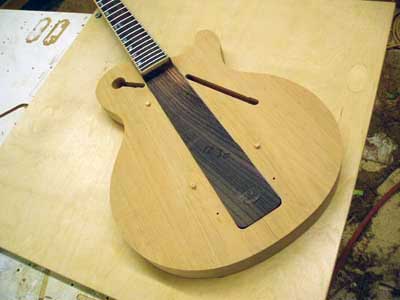
As you can see, the length of wood for the neck extends further than a typical set neck, but not as far as a neck-thru (covered later).
Set-through guitars are far less common and you’re more likely to see either a set neck or a neck-thru.
The reason these are less common is that it’s a lot easier for a manufacturer to build a set neck guitar compared to a set through guitar. Instead of mounting the neck, then routing out the holes for the pickups, the neck can simply be attached after the guitar body has been finished.
Set Neck Pros and Cons
Here are the main pros and cons to consider with set neck guitars. Keep in mind that everybody has different preferences, so some of these may not apply to you.
Pros:
- Sometimes offers better upper fret access and comfort than bolt-on necks
- Tend to look better than bolt-on necks
Cons:
- Very difficult or impossible to repair or replace damaged necks
What are Neck-Thru Necks
The last type of guitar neck joint is very different from bolt-on necks or set necks.
Neck-through (or commonly spelled neck-thru) guitars run the neck’s length of wood all the way through to the end of the body. There is no neck joint because the neck runs the entire length of the guitar.
A piece of wood is added to both sides of the neck to form the ‘wings’ of the guitar’s body.
In the below photo, you can see the basic idea behind a neck-thru guitar:

The key point with a neck-thru guitar is that the neck runs the entire length of the body.
Necks can be one piece or a laminate of three or more pieces as shown below:

The above Ibanez uses five lengths of wood laminated together to form the neck, which creates an incredibly durable neck.
Neck-thru designs are very common with basses due to the extra strength compared to bolt-on or set neck joints.
The major benefit of a neck-thru guitar is the freedom for the manufacturer to shape and contour the neck in ways that aren’t possible with a bolt-on neck.
Compare the two guitars below and think about how comfortable each one would feel as you reach for the highest frets:
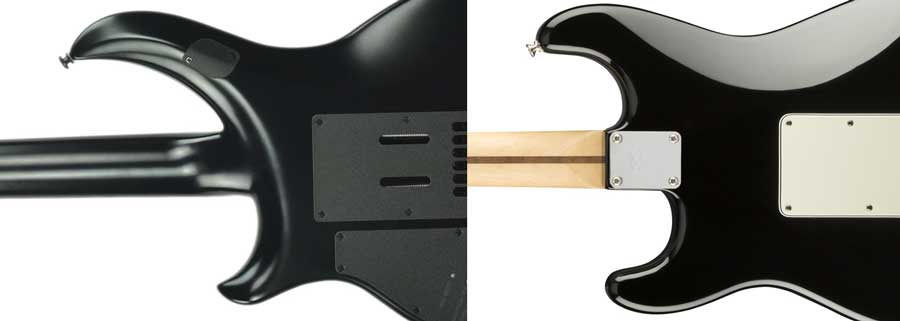
The above neck-thru guitar (an Ernie Ball Music Man Majesty) has been the most comfortable guitar I’ve ever played so far. The smooth contour as the neck reaches the body made it ridiculously easy to play the upper frets. Going back to my bolt-on guitars afterward felt clunky in comparison.
Of course, this doesn’t mean every guitar should be built using a neck-thru design. Everybody has different preferences and there are pros and cons to each style of construction.
The main point to remember with neck-thru guitars is that they’re usually far more comfortable in the upper range.
The other benefit that is usually mentioned with neck-thru guitars is with tone and sustain. The basic idea is that because there is no joint and the neck runs the entire length of the guitar, you get ideal resonance in the guitar.
Neck-thru guitars are commonly seen as having the highest sustain. As I’ll cover later, this isn’t as straight-forward as guitarists commonly believe.
Neck-Thru Pros and Cons
Here are the main pros and cons to consider with neck-thru guitars. Keep in mind that everybody has different preferences, so some of these may not apply to you.
Pros:
- Offers the best upper fret access and comfort out of all neck joint types
- Incredibly strength and stability (which is why it’s common for basses)
Cons:
- Impossible to replace damaged necks
- More difficult and expensive to build
Bolt-On vs Set Neck Comparison
The most common two types of neck joints you will need to compare are bolt-on and set necks.
These two types of neck joints are the most common because they’re the cheapest to build when compared to neck-thru guitars.
Let’s go through some important things to consider if you’re comparing a guitar with a bolt-on neck and a set neck.
Cost
The conventional view is that bolt-on necks are cheaper than set necks. But you may notice that a lot of entry-level guitars today use set necks.
In the past, bolt-on necks were cheaper to produce, but that’s no longer true today thanks to CNC machines (as shown below).

Almost all guitar bodies today are cut with a CNC. This means the neck pocket will always have a precise size.
The size of a neck pocket is crucial to set neck joints, so it’s no surprise that CNC cut bodies make set neck joints much cheaper to manufacture.
Another reason set neck guitars are becoming more common for entry-level guitars is that guitarists tend to think of set necks as having better sustain and better overall quality than bolt-on necks. So manufacturers have an incentive to use set necks on their entry-level guitars because they know people tend to see set necks as the better choice.
The key point to remember is that there really isn’t much difference in terms of cost to build a guitar with a set neck or bolt-on neck.
Quality
Because people tend to think that bolt-on necks are cheaper than set necks (not true as explained above), people also tend to think that it means set necks are always better quality.
Any guitarist who has experienced a poorly built set neck guitar will tell you that’s not always true.
Poorly built set neck guitars are very possible, just like poorly built guitars with bolt-on necks.
At the higher range, both set necks and bolt-on necks can have impressive quality joints. It all depends on the manufacturer.
Tone
The problem with comparing bolt-on and set-neck guitars is that there are so many other features of a guitar that also impact tone.
People tend to compare set necks and bolt-on necks by comparing Les Pauls and Stratocasters.
One glance at the below photo and it will be clear why this is a bad way to compare the neck joints:

While the neck joints are different on these two guitars, there’s clearly a lot of other differences that will impact tone far more than the neck joint.
People tend to associate Stratocasters with a snappy or twangy tone and a Les Paul with a warm and high sustain tone (compare Les Paul to Strats here).
It should be no surprise then that that’s exactly how people describe the tone you get from bolt-on and set neck joints.
I’ll cover tone in more detail later, but the key point to remember is that there are so many other things on a guitar that impacts tone and the neck joint plays less of a role than most people think.
Playability and Comfort
Bolt-on and set neck guitars often feel very similar to play. Some set neck guitars have ergonomic contours that give you easy access to the upper frets, while others have big fat heels that feel weird (I’m looking at you, PRS).
Some bolt-on necks use a metal plate at a flat angle, while other guitars don’t use neck plates or angle the neck plate to make it more comfortable to play.
There are so many different variations in each type of joint that it is hard to compare. If you play a guitar with a bolt-on neck that you don’t like the feel of, it doesn’t mean that you will hate all bolt-on necks (likewise with set necks).
Every guitarist has a different idea of what makes a guitar comfortable, so the best advice is to try a lot of different guitars with different neck joints to figure out which you prefer.
Set Neck vs Neck-Thru Comparison
The main difference when comparing set necks and neck-thru guitars is what how the manufacturer is able to shape and contour the joint.
Set neck guitars usually have a heel while neck-thru guitars tend to smoothly transition from neck to body.
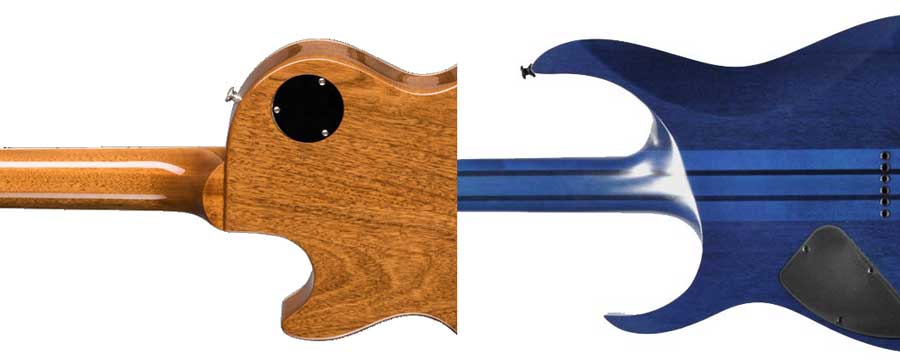
Some guitarists prefer the feel of a set neck, while others prefer the feel of a neck-thru.
While neck-thru guitars are more expensive to build, you will still see plenty of extremely expensive guitars using set necks.
Guitar Neck Joint Tone and Sustain Myths
If you ask somebody what a guitar with a bolt-on neck sounds like, the typical view is that they have a snappy or twangy tone without much sustain.
You’ll probably be told that because the neck isn’t glued to the guitar body, less of the string vibration is transferred from the neck to the body.
Ask about a set neck, and you’ll be told they have better sustain than bolt-on necks, due to the glue holding the joint together.
Ask about a neck-thru guitar, and you’ll be told they have the best sustain because the string vibration perfectly travels the length of the entire guitar.
This all sounds perfectly logical, right?
The problem is that it doesn’t hold up to testing.
Testing Sustain
The below image shows the spectrogram from this study comparing the sustain of all three types of neck joints:

The more color you see in the graph (especially yellows and reds), the better the guitar’s sustain.
Think about how you would rank the three graphs based on how much sustain each one has and think about what type of guitar was used for each one.
The result pretty much everybody would expect is for the bolt-on to have the least sustain, the set neck to have the middle result, and the neck-thru to have the best sustain.
Well, here are the results:
- Top graph: neck-thru
- Middle graph: bolt-on
- Bottom graph: set neck
What shocked me is that the middle graph with clearly the highest sustain was the bolt-on neck.
Here’s a different test he ran showing the sustain for four different types of neck joints:

It’s pretty clear that the bolt-on necks produced the best sustain, followed by the set neck, then the neck-thru.
In other words, the complete opposite of what most people expect.
After scratching my head for a while trying to understand why these results completely turn things upside down, I found a different site that came to similar conclusions when comparing a Les Paul to a Strat.

As you can see, the Strat has considerable more sustain than the Les Paul at the open strings, while the Les Paul had slightly higher sustain at the upper frets.
I wouldn’t take any of these tests as rock-solid evidence, but the key point to remember is that nothing is ever straightforward when it comes to guitar.
Guitarists tend to get ideas in their heads and will believe it regardless of evidence.
While the type of neck joint does impact tone and sustain, it’s only one out of many factors to consider. So don’t choose which type of neck joint you want based on tone. Consider the entire guitar as a package.
Guitar Neck Joints FAQs
Here are some common questions you may have about guitar neck joints:
How are guitar necks attached?
Guitar necks are attached using one of three types of neck joints. A guitar neck can be bolted on to the guitar (bolt-on), glued to the guitar body (set neck), or run the entire length of the guitar (neck-thru).
Is it Bad to Take the Neck Off a Guitar?
Taking the neck off of a guitar will not cause damage if done properly. Bolt-on guitar necks can be removed for repairs or replacement.
When the neck is screwed back on to the guitar, it will take some time for the neck to settle with the change in tension.
Can You Put a Strat Neck on a Tele?
You can only replace a guitar’s neck if the neck fits the same size pocket. Some guitar necks have a rounded end, while others have square ends. While it is possible to put a Strat neck on a Tele, it isn’t a perfect match and will poorly fit.
Which Guitar Neck Joint is Best?
There is no best guitar neck joint because every guitarist has different preferences. Some guitarists like the sound and feel of a bolt-on neck, others prefer the finish of a set neck, while others like the ergonomics of a neck-thru guitar.
The only way to know which type of guitar neck joint is best for you is to try out a lot of different guitars and see what feels right.
Learn more about guitar necks in these guides:
- Guitar Neck Shapes and Fretboard Radius
- Guide to Truss Rods
- Guitar Scale Length
- Guitar Action Height
- Guide to Intonation
If you take the time to read all of the above guides, you’ll know everything you need to be able to perfectly set up your guitar for optimal playability.
